You’ll find famous names of South Jersey’s historical figures emblazoned on buildings, plaques, street signs and one other place, too: their tombstones. South Jersey is home to some of the most beautiful, unique and historic cemeteries in the country, and people come from miles away – and, in some cases, across oceans – to visit the famous graves. Most visitors aren’t looking for anything creepy or morbid. More often, they’re in search of a history lesson.
 Siloam Cemetery, Vineland
Siloam Cemetery, Vineland
Siloam was built in 1864 on a plot of land donated by Charles K. Landis, the founder of Vineland. At first glance, the original part of the cemetery can seem more like a park than a burial ground. It’s not hard to see why Landis called it “the beautiful city of the dead.”
“It’s a garden landscape,” says Chris Mohan, a member of the cemetery’s board who leads historic tours there. “That was very common in the Victorian era. You can still see the remains of the original winding footpaths, and there are lots of bushes and shrubs and flowering trees. In some places you don’t even realize you’re in a cemetery.”
A stroll through Siloam is an incredibly intriguing lesson on Vineland’s history. In addition to Landis, Siloam is the final resting place of Thomas Welch, who started Welch’s Grape Juice near the spot of the present-day Vineland Police Department. Henry Herbert Goddard, the psychologist who stumbled into infamy with his studies in eugenics that would eventually inspire Hitler’s “final solution,” is buried there, alongside Edward R. Johnstone, an acclaimed psychologist whose leadership of a school for children with developmental disabilities continues to inspire educators today.
“Mr. Johnstone fired Goddard from the school,” Mohan says. “We like to joke that even in death, Mr. Johnstone is keeping an eye on Mr. Goddard.”
Mohan, a teacher at nearby Vineland High School, often brings students to Siloam to learn about their local forefathers (and mothers – there are several prominent suffragettes buried there).
“We have all this amazing history in South Jersey that students rarely learn, because it’s just not covered,” Mohan says. “Being here and seeing the monuments – some of them are 10, 12 feet tall – gives students a much greater understanding of how important these people were. They walked the same streets we walk today. The cemetery gives us a way to connect with our ancestors and keep the history alive.”
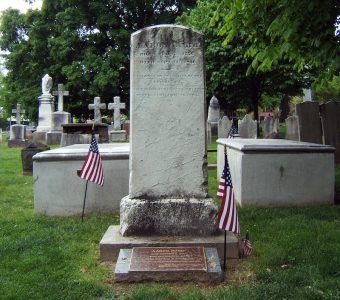
Aaron Burr Jr.’s tombstone. Photo: Tony Fischer
Princeton Cemetery, Princeton
A 19th-century historian referred to Princeton Cemetery as “the Westminster Abbey of the United States.” The name on the cemetery’s oldest tombstone is a famous one – in 1757, former Princeton University president Aaron Burr Sr. was the first person to be buried there – and the stones only get more impressive from there.
At the elder Burr’s feet is the grave of his son, Aaron Burr Jr., who served as both New York State attorney general and vice president of the United States, but is best known for the duel in which he shot and killed Alexander Hamilton.
“There’s been a big uptick in interest in the Burr grave in the last couple of years,” says Linda Gilmore, the cemetery’s business administrator. “Since the musical ‘Hamilton,’ people have been leaving lots of tokens – coins and flowers – on his grave.”
Visitors don’t just come for Burr. Gilmore says the cemetery’s caretakers also find a large number of items on the grave of President Grover Cleveland.
“People make pilgrimages from Hawaii to his grave,” she says. “He opposed annexing Hawaii and respected the authority of their sovereign queen, so they come and leave shells and leis on his grave.”
Cleveland’s grave is flanked by those of his wife and his daughter Ruth, who died of diphtheria at age 12, and for whom the “Baby Ruth” candy bar is said to be named.
The list of notable names goes on and on: Wall Street Journal editor Bernard Kilgore, U.S. Senator Richard Stockton Jr. and pollster George Gallup.
“There are some really interesting tombstones and markers,” Gilmore says. “We’ve cleared a lot of overgrown bushes in the last few years and uncovered a really beautiful tall narrow Celtic cross. People also love William Hahn’s stone, which says, ‘I told you I was sick.’”
The marker over philanthropist Paul Tulane’s grave features a huge statue of Tulane that faces away from Princeton University across the street.
“This could be an urban legend, but people say Tulane planned to give all his money to Princeton University on the condition they rename the school after him,” Gilmore says. “They wouldn’t, and so he took his money to New Orleans and now that’s where Tulane University is. So people say his back is turned intentionally toward Princeton.”
Gilmore says it’s tough to estimate how many visitors Princeton Cemetery gets each year, but the on-site office goes through more than 1,000 maps of the grave markers annually.
“It’s a community place,” Gilmore says. “It’s always been a community burial ground, and it’s right here in the middle of downtown Princeton. In fact, it’s really the only green space downtown, so in some ways I think it functions a bit like a local park.”
 Finn’s Point National Cemetery, Salem
Finn’s Point National Cemetery, Salem
Finn’s Point isn’t a tourist hotspot, and it isn’t easy to find. Located on 4.6 acres along the bank of the Delaware River in Salem, it’s completely surrounded by the Killchohook National Wildlife Refuge. But behind the tall grass, this quiet, well-kept burial ground holds an important piece of N.J. history. There are just over 3,000 people buried at Finn’s Point, and nearly 2,500 of them were Confederate soldiers.
Just prior to the Civil War, the federal government built a massive defensive battery – Fort Delaware – on Pea Patch Island in the middle of the river to protect the ports of Philadelphia and Wilmington. During the war, the fort became a prisoners of war camp, and though it was built to hold 4,000 men, there were nearly 22,000 Confederate troops imprisoned there over the course of the war.
“Malnutrition and disease were common in Civil War-era prisoner of war camps,” the National Park Service writes. “Nearly 2,500 prisoners died while held captive at Fort Delaware.”
The dead Confederates were ferried to Finn’s Point, where many were buried in unmarked graves. By the end of the war, 135 of their Union guards would join them.
There are two large monuments on the property. The first, in honor of the Union soldier, was built in 1879. In 1910, the U.S. government erected an 85-foot-tall concrete and granite obelisk, which lists the names of the 2,436 Confederates who died at Fort Delaware.
“Perhaps the most unusual and unexpected graves in the cemetery are to be found in the northwest corner,” says Elyse Cramer, who wrote about Finn’s Point for Weird N.J. “Thirteen white marble headstones mark the burial place of German prisoners of World War II who died while in custody at New Jersey’s Fort Dix.”
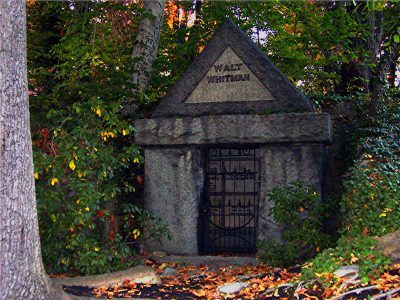
Harleigh Cemetery, Camden
From Haddon Avenue, Harleigh Cemetery appears to be a well-landscaped park. Footpaths lead to small ponds below shady trees, and gentle hills slope down to the Cooper River.
“This is one of the most beautiful cemeteries in the country,” says Alan Green, the sales manager of Cemetery Development Co., which manages Harleigh. “When you come through the gates it’s a whole ’nother world. There are trees and hills and lakes – it was designed as a park.”
Green says locals spend time in the cemetery – it’s a great place for a picnic or a lunchtime stroll – but many visitors come from much further away.
“People come and visit from all over the world,” he says. “They come to see Walt Whitman.”
Whitman, who spent his final years in Camden, designed his own tomb on a 20′ x 30′ plot of land gifted to the poet by the Harleigh Cemetery Foundation. He ordered a “plain massive stone temple” with an iron gate and large bronze lock. Whitman checked in frequently on the construction and proudly reported to friends that the tomb was a celebration of his life and personality. He was buried there in 1892.
“Poets will come and do readings there,” Green says. “A lot of people come to get inspired or to honor Whitman because he’s inspired them already.”
One such visitor was Jim Morrison of The Doors, who visited Whitman’s tomb sometime in the 1960s and left his own mark.
“Morrison came because he was a poet too,” Green says. “He signed a tree by the tomb, and you can still see his signature.”
Today Morrison’s grave in Paris is, ironically, one of the most visited burial sites in the world.
Whitman isn’t the only well-known Jersey resident laid to rest in Harleigh. It’s also the final resting place of Camden haiku poet Nick Virgilio, four senators and more than 300 Civil War veterans.
In 2007, Harleigh was named Camden County’s Veterans’ Cemetery.
“We have a Memorial Day ceremony every year, and many of the families, many of the Gold Star Mothers, attend,” Green says. “It’s a way to commemorate the veterans of Camden County and to say thank you.”
Green says Harleigh’s management and caretakers know they’re responsible for more than just a place where bodies are buried.
“There’s so much going on here,” Green says. “There’s so much history and so many interesting stories.”
More Notable Names
The list of famous folks buried in New Jersey goes on.
Alice Paul
A staunch feminist, women’s rights activist and one of the leaders of the women’s suffrage movement, Paul was one of the main strategists of the campaign for the 19th Amendment to the U.S. Constitution. In 1977, she was buried near her childhood home at Westfield Friends in Cinnaminson.
Thomas Edison
Edison’s first big idea – the phonograph – was invented in Newark. He’d go on to invent the light bulb, carbon microphone and telegraph. After his death in 1931, he was buried behind his home in West Orange.
Jersey Joe Walcott
The boxing great, whose real name was Arnold Cream, became heavyweight champion of the world and the first African-American sheriff of Camden County before he was laid to rest in Pennsauken’s Sunset Memorial Park in 1994.
Goose Goslin
The left fielder gained his fame outside N.J., playing 18 seasons with the Washington Senators, St. Louis Browns and Detroit Tigers. He was inducted into the Baseball Hall of Fame in 1968 and buried in 1971 at Baptist Cemetery in his hometown of Salem.
Sam the Plumber
Sam DeCavalcante, who led N.J.’s most infamous crime family for nearly two decades, is buried in Greenwood Cemetery in Hamilton Township.
John Roebling
Though he’s buried in New Jersey, you can thank Roebling when you drive through New York; he designed and built the Brooklyn Bridge. He’s buried in Trenton’s Riverview Cemetery.
John Taylor
This name might not sound familiar, but if you’re from South Jersey, you know it. The businessman and politician, who died in 1909, is the creator of Taylor Pork Roll, and if you want to pay your respects, you can visit his grave at Riverview Cemetery. Maybe bring a breakfast sandwich.


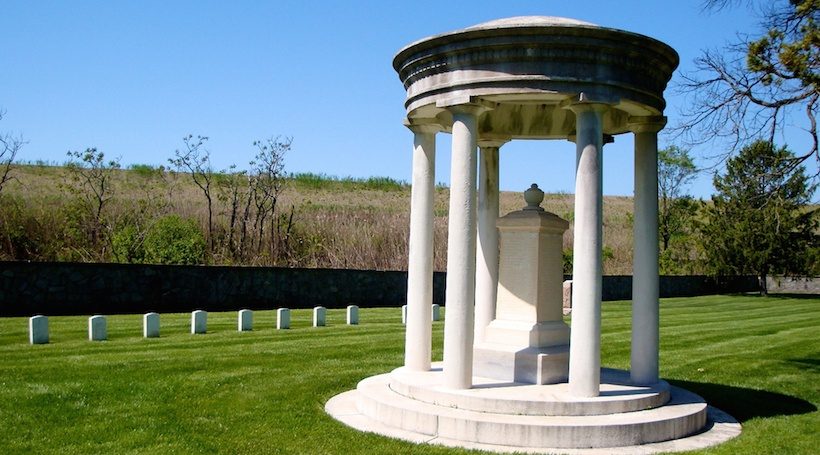
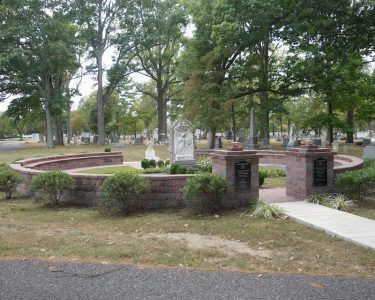 Siloam Cemetery, Vineland
Siloam Cemetery, Vineland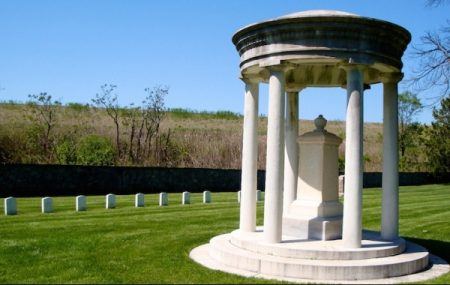 Finn’s Point National Cemetery, Salem
Finn’s Point National Cemetery, Salem









